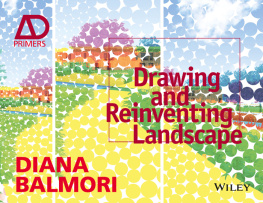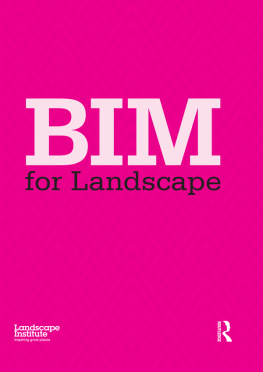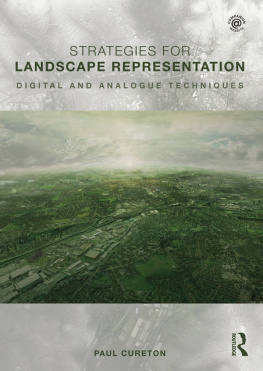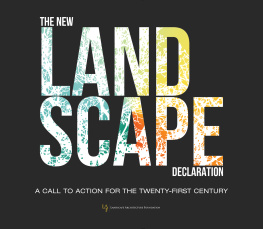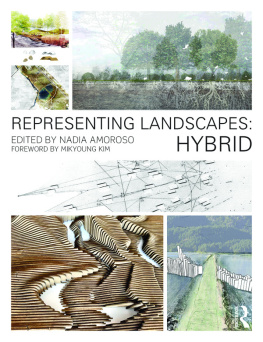Drawing and Reinventing Landscape
This edition first published 2014
Copyright 2014 John Wiley & Sons Ltd.
Registered office
John Wiley & Sons Ltd, The Atrium, Southern Gate, Chichester, West Sussex, PO19 8SQ, United Kingdom
For details of our global editorial offices, for customer services and for information about how to apply for permission to reuse the copyright material in this book please see our website at www.wiley.com .
All rights reserved. No part of this publication may be reproduced, stored in a retrieval system, or transmitted, in any form or by any means, electronic, mechanical, photocopying, recording or otherwise, except as permitted by the UK Copyright, Designs and Patents Act 1988, without the prior permission of the publisher.
Wiley publishes in a variety of print and electronic formats and by print-on-demand. Some material included with standard print versions of this book may not be included in e-books or in print-on-demand. If this book refers to media such as a CD or DVD that is not included in the version you purchased, you may download this material at http://booksupport.wiley.com . For more information about Wiley products, visit www.wiley.com .
Designations used by companies to distinguish their products are often claimed as trademarks. All brand names and product names used in this book are trade names, service marks, trademarks or registered trademarks of their respective owners. The publisher is not associated with any product or vendor mentioned in this book.
Limit of Liability/Disclaimer of Warranty: While the publisher and author have used their best efforts in preparing this book, they make no representations or warranties with respect to the accuracy or completeness of the contents of this book and specifically disclaim any implied warranties of merchantability or fitness for a particular purpose. It is sold on the understanding that the publisher is not engaged in rendering professional services and neither the publisher nor the author shall be liable for damages arising herefrom. If professional advice or other expert assistance is required, the services of a competent professional should be sought.
ISBN 978-1-119-96702-6 (paperback)
ISBN 978-1-118-54117-3 (ebk)
ISBN 978-1-118-54118-0 (ebk)
ISBN 978-1-118-54119-7 (ebk)
ISBN 978-1-118-83057-4 (ebk)
Executive Commissioning Editor: Helen Castle
Project Editor: Miriam Murphy
Assistant Editor: Calver Lezama
Their elegant necks angled down as everything sloped
toward the river more than a mile across there,
full of sandbars whose shapes
the water slowly rearranged, so no map
ever stayed exact.
Debra Nystrom
(from Pronghorn, The New Yorker, 13 May 2013, p 37)
Acknowledgements
Many scholars and researchers have helped to put this book together and have shepherded it through the convoluted two-year path of its writing, in the face of many demands that the design work in a landscape office demands. It has been a pleasurable experience, however, and I was helped in this by my editor Helen Castle who understood and gave me some breathing room when I had to extend a deadline, and gave support to my request for a landscape rather than a portrait format for this book, the books on architectural representation published as part of this series being all vertical.
Michel Conan, former Director of Garden and Landscape Studies at Dumbarton Oaks, was a careful and important critic throughout the development of this manuscript. In particular I am most grateful for his insights about my own work, and for always making me go further in the expression of ideas.
Lauren Jacobi at the start of this writing, a graduate student in Art History at the NYU Institute of Fine Arts, now starting as new faculty in Architectural History at MIT was a critical help in finding material that I needed as well as writing to different scholars to amplify particular points, or to add new interpretations based on new research.
Nomie Lafaurie-Debany, Principal in Balmori Associates, cast her meticulous eye over the whole text and illustrations and was a most thorough critic as well as contributor in seeing the lack of some things in the text, and excessive material on others.
Elizabeth Segal has been the excellent editor to whom I always turn to force clarity out of my prose, the quality I prize more than any other. She is always my sounding board and ultimate recourse to get where I want to be.
Isabelle Desfoux, a designer in my office, helped to try out different scenarios for our design for the cover which went through many iterations and different approaches in colour, theme and composition.
Finally, Caroline Ellerby was most helpful and patient in seeking the permissions for the many illustrations, but most of all in being tenacious when we were sent alternatives of images which differed from the ones we wanted, pursuing by hook or by crook the right ones, making for a better book.
Foreword
Attuning the Mind to the Ebbs and Flows of Nature
This is a challenging book for all of us who have ears and hear not. Changes happening before our eyes, even radical changes, may be obvious and yet invisible because they are outside the frames of our understanding. Diana Balmori makes three claims: first, that our views of nature are undergoing a radical change; second, that as a result, landscape architecture is called upon to reinvent itself; and third, that drawing will be a key instrument in that reinvention. At first sight, we may dismiss outright the radicalism of these changes. Everybody, or at least every landscape architect in the Western world, knows that a global ecological awareness is transforming humans attitudes towards nature. After all, isnt it an ongoing process that started about half a century ago, with Earth Day symbolising that shift? How could this be a radical change now? In truth, landscape architecture took a radical turn with Ian McHargs Design with Nature, which was published in 1969 again, more than four decades ago. Last, and most paradoxical, is the idea that hand-drawing could be a source of professional renewal for landscape architecture when computer screens have made tracing paper obsolete, and social media are about to displace the newspaper. These are the real changes that everybody can see, and there is nothing fundamentally new happening before our eyes. Or is there?
Balmori herself was involved throughout the last third of the 20th century in American landscape architectures shift towards ecological and environmental awareness. She was also engaged in dialogue with her colleagues at Yale and in New York City, who participated in the transformation of ecological thinking in science, in the debates it triggered in urban planning, and in its impact upon the arts. In her eyes, it is not the idea of nature as a living system that includes human beings that is new; it is the necessity to renounce a long-held and cherished belief in natures capacity for self-regulation that is, in its ability to return to its former state of balance after disruptions that have accumulated since the beginning of the industrial revolution. Nature is no longer a point of reference, a polar star towards which humans can try to steer the course of living beings, the climate and the oceans. Nature is an unfathomed becoming; and scientists, like oarsmen rowing a scull to a future to which their back is turned.

